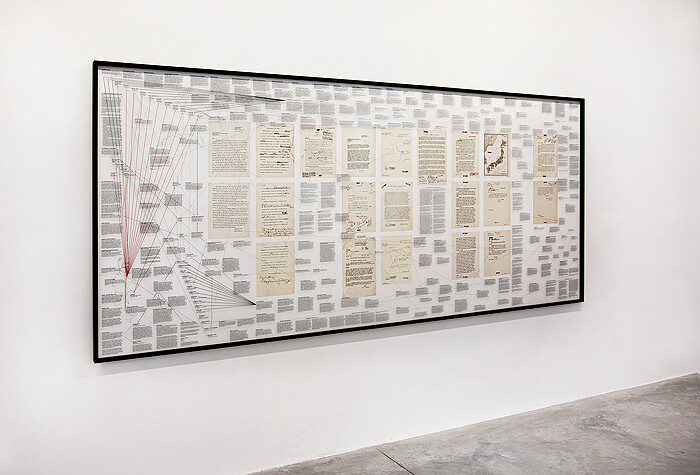After Hiroshima, after Chernobyl, after Fukushima, it is time, once again, to speak about atoms. However, the title of Gert Jan Kocken’s Spartan yet powerful exhibition teases us with another question: what language shall we use, and how will such a choice temper or frame the conversation? Although the title is borrowed from Nobel Prize-winning physicist Werner Heisenberg, Kocken appears to be interested not only in a review of scientific thought, but moreover, how tangential elements are stratified into the language of written history. Spinning out intricate allusions to split-mentalities and motives with various chains of actions and reactions into the essential structuring device, the artist advances his telling in the exhibition’s centerpiece, Fission (2013).
Fittingly, Fission presents two twinned, yet fractured “infospheres” united under a larger glass window. The first are a group of reproduced declassified political dispatches, which justify the American dropping of the atomic bomb on Hiroshima, while the second depicts the massive networks, discoveries, and communications required to develop the American, German, and Soviet nuclear programs respectively through the use of linked captions printed directly onto the glass. Although the work takes the appearance of a giant flowchart, the choice of information and its placement betrays Kocken’s editorial skill as he recuperates, cuts, and/or circles back to various themes and players.
By eyeing the captions first, a viewer might follow the diaspora of physicists displaced by the Nazi ban on Jewish scientists and their subsequent exile throughout the 1930s and 1940s. Key among them is Leó Szilárd, a Hungarian-born American physicist who can be seen as the main protagonist weaving through Fission’s two sets of documentation.
Szilárd more-or-less kick started the Manhattan Project by drafting a letter—a copy of which is held under Fission’s glass—to then US President Franklin D. Roosevelt explaining the German nuclear weapons program, headed by Heisenberg, and urging FDR to begin research on a similar project to counter the Nazi nuclear threat. Wary of both the complexity of the issue, and his own relative obscurity in the public mind, Szilárd had Albert Einstein sign the letter so as to bring the added heft of the physicist’s cultural capital. (Ironically, Einstein himself had only the slightest familiarity with this branch of nuclear engineering.) Such trivial, yet essential politics grounds most anecdotal science, i.e., when and where the atom was first spit and so forth. The story of Fission is not only one of scientific pursuit, but also of political jockeying and conflicting personal agendas. In one bizarre instance, Heisenberg’s mother beseeches the mother of Heinrich Himmler, Reichsführer of the SS, to have her son intercede on Werner’s behalf… which he does.
Lurching forward—the plane of the glass reads right to left chronologically—the anti-Nazi argument for the bomb fizzles when the Third Reich is defeated. Scrambling for new justifications, the American Forces, now under the direction of President Truman, create several rationales for deploying nuclear arms against the Empire of Japan. Competing archival documents and further captions contest the theory that the bomb should be used to hasten Japanese defeat so as to forestall the high losses projected through a conventional invasion—others, including a now possibly guilt-ridden Szilárd, propose to merely drop the bomb on an unpopulated site as a show of force. Unswayed, Truman gives the go to bomb Hiroshima. Characteristically, this rationale itself is graphically broken into divergent positions that are heightened through Kocken’s subtle webs, and their connections.
Further declassified materials are held up to purpose the arbitrariness of the attack itself—namely, an Army Air Force map with Hiroshima added to it (as a “military base”) just days before the bombing, and a copy of Truman’s public address on the detonation, wherein the name “Hiroshima” is simply penciled in a blank space as an afterthought. Now ready to drop a bomb all his own, Kocken uses a caption in the lower corner of the work to bookend, and, importantly, invert Fission’s events. Here, a troubled Einstein laments that signing the FDR letter was the “one great mistake” of his life. And yet, a little ethical cliffhanger explodes off this caption as Nazi-cum-NASA rocket scientist Werner von Braun basically states he’d work for anyone who could pay—which he did, of course.
Fission is joined by a few other works juxtaposing various such artifacts to build contradictory or troubling accounts of the “official history” of the nuclear age, but one in particular flags Kocken’s style of research and presentation. Y-3, Q-3, B-2, C-1 (2010) seems to be a black-and-white aerial photo of the aftermath of the Hiroshima bombing; however, the top corner strangely holds the dedicated autograph of the run’s pilot, Colonel Paul W. Tibbets. Here too, the work’s protective glass carries printed matter, which becomes part of the piece. This time though, the twin stories of Tibbets and Major Claude Eatherly set the stage. (Eatherly was the pilot who radioed Tibbets on that fateful day to tell him that the weather was clear and as such, Tibbets should bomb the target.) As these stories play out, we read how Tibbets later gloated about his “work”—the photo is in fact one of his own publicity shots he would sign in public for money—while Eatherly went on to suffer mental breakdown after breakdown for his complicity in the event. With a formal wink to these two positions of pride and guilt, Kocken implicates the viewer as a kind of moral surveyor that must review the pilot’s gaze through the lens of these ethical poles.
Although these works could be read collectively as critical expressions of the nuclear age, Kocken’s depictions are more matter-of-fact and inevitable than sensational or accusatory. If anything, they task the viewer to speak not about the knowledge of discovery, of science, and of technology, but of social phenomena. With such refection, it might be possible to resituate and reanalyze today’s ongoing cycle of “crises”—be they presented as ecological, economic, or otherwise—not as abstract scientific problems, but rather as divisive political explosions.






